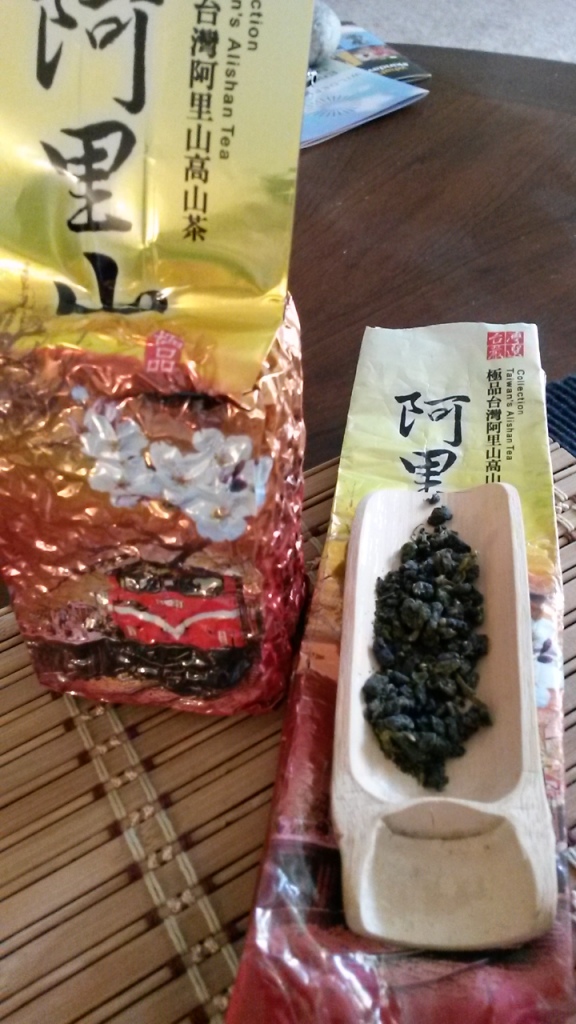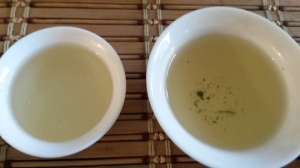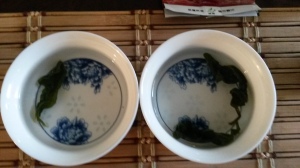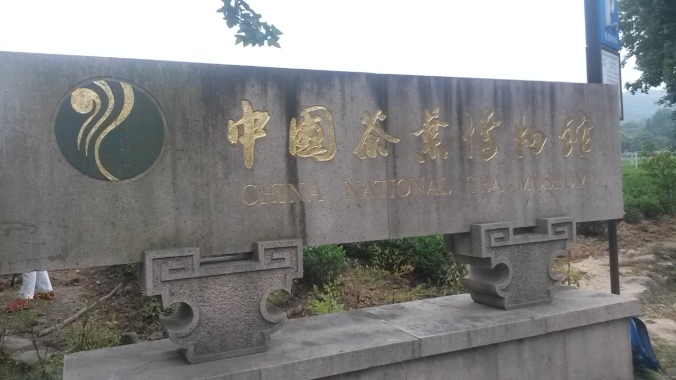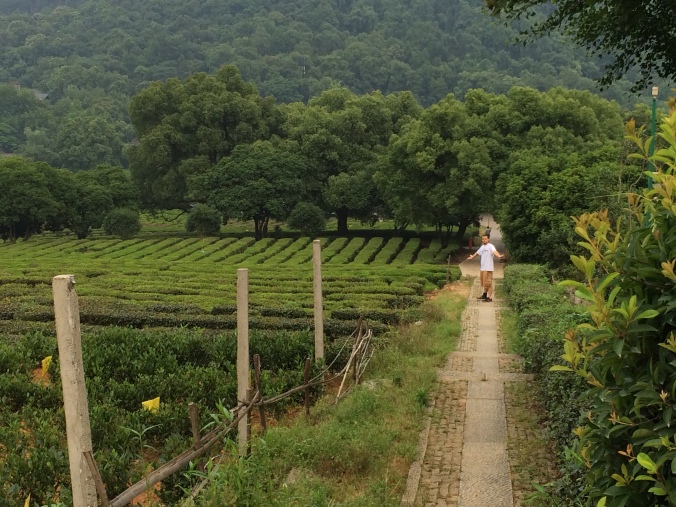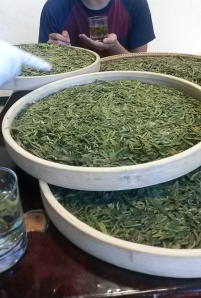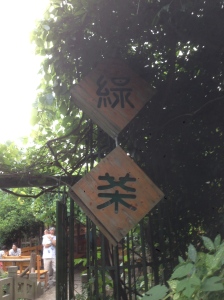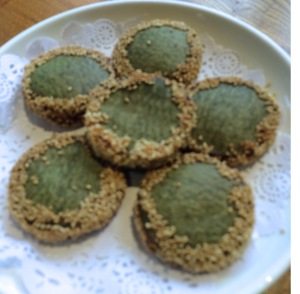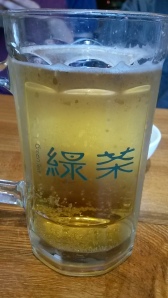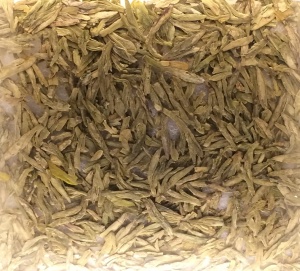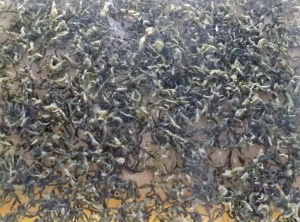Finally moving things to my own domain. All future posts after this post will be on Murphcha.com.
10 Things I didn’t feel right leaving out of the Green Tea Section…
Here are 10 Things I didn’t feel right leaving out of the Green Tea Section.
- Quality & Brewing
- Choose good tea. You can’t expect good tea from low quality leaves, no matter how well you brew it.
- Brewing For Others
- Learn to brew your tea first before sharing with customers. Once you understand the tea, quality, temperature to brew at, and method, you can manipulate it depending on what your customer wants.
- Pour Height
- If you pour from a greater height into and out of the vessel, the temperature will drop. This could speed up the cooling process and get the tea to a comfortable drinking temperature.
- Where To Pour
- Do not pour hot water directly on the leaves. If you are using a gaiwan or glass pour onto the side of the vessel. Remember the leaves are delicate.
- Extra Leaves
- When you are brewing be careful of the extra leaves you may leave in a cup or serving pitcher. These leaves continue to brew while they are still in the vessel. After a little while they could make the tea bitter.
- Not all green teas can withstand 100 degree Celsius temperature
- Now for Americans like me I can’t relate to the metric measurement system. So I like to say the best temperature to brew at initially is a temperature that is not burning your fingers when you touch the outside of a glass cooling pitcher. If you can physically touch the outside of the cooling pitcher for 3 to 5 seconds then it is most likely ready. If you are using a different cooling pitcher, or maybe just the kettle, you can test this by putting your hand over the top of the vessel. Again you want to be able to hold your hand above the open vessel for about 3 – 5 seconds again. **If this is still difficult to understand, test this yourself with some type of temperature recording device. Or practice until you get it.
- Practice
- Green tea can be difficult to brew if you don’t practice brewing green tea.
- Competition & Delicacy
- If you over brew the first brew of green tea, there is little chance that you will be able to correct that mistake in future brews.
- Have your guest rinse their mouths with boiled water before you serve them the next brew.
- If you over brew the first brew of green tea, there is little chance that you will be able to correct that mistake in future brews.
- Amount
- Watch the amount of tea you put into your vessel. It could have the same effect of over/under brewing the tea.
- Enjoy your tea.
- Always
A Wall of Notes
It seems like I am always learning something new about tea and taking down notes here and there. I usually take notes on small sheets of paper and at the end of the day I just place them in a pile on my desk. My approach to typing up notes has been centered on typing up or fixing my oldest notes first. It usually takes me a while to get to them since I am always side tracked by new information. Recently I had decided to change this mentality.
So instead of just adding to the stack of notes all over my desk, I am just going to type up my most recent notes right away. Every so often I will type up a set of old notes and add them to what I have. Hopefully this approach will allow me to post more often and start to cut down on the mess on my desk.
Recently I added a section to my notes page of notes that I look forward to processing soon. The files you see in this section are all unprocessed and will be updated as I narrate through them.
Check out the notes page here!
I’m excited!
Fiji Water Experiment!
Part of the water series!!!
Ali Shan Oolong Comparison
Ali Shan Oolong Comparison
阿里山
It’s been a while since I have done an experiment. So today I have decided to do a comparison that have been holding out on and wanted to do for some time. This experiment compares two of the same teas. One tea was opened 6 months ago, while the other was just opened today, 11/24/2014. Both of these teas are roasted teas from Alishan.
The test is to see if there is any major differences in the recently opened tea and the tea that has been open for the last six months. The procedure for this test is simple and I am going to try to keep as many constants as possible. I will use a similar gaiwans with similar amounts of tea. I will brew with spring water just of the boil, for three brews. I will taste them both side by side, with a rinse in-between each tea.
In the picture above you see the results of the first brew. The one on left is the recently opened bag. The initial and most obvious difference is the color of the liquor. The tea on the right seems to be a little darker or deeper in color. The one on the left is brighter and sort of shines.
I poured and brewed the one on the right first, with the one on the left directly afterwards. To my surprise the one on the right was a lot more stronger and more rounded than the one on the left. The tea on the left was strong, but not stronger than the other. There was also a small amount of bitterness. Both teas were nutty and hinted of plum or dried fruits.
This is the result of the second brew! Again the colors are a little different but not by much. The oolong on the left was a lot smoother the second time around. It was also sort of building in strength. The tea on the right was still stronger and doing well!
.
.
.
Notice the size of the leaves. The first tea was nearing the end of the bag, so the leaves are a little smaller.
The third brew was where the recently opened tea separated itself. The tea from the recently opened bag gave off a nice effervescence or activity on the front of the tongue and was clean in the mouth. There was a building roast that sort of left a cooling presence afterwards. This tea peaked here. The other tea sort of fell off and didn’t live up to the newly opened tea.
In conclusion, there was not a major difference in the overall taste of the tea. I would not say that either tea went stale or that they were impacted greatly by the environment.The tea that was recently opened did keep more of the effervescence that I look for in Alishan. But at the end of the day, I can clearly tell that these two teas are from the same source.
***Let me know of some of the differences you have tasted in your oolongs that have been through different storage in the comment section!***
Here are some pictures from my visit to Hangzhou’s Tea Museum. Hangzhou in general is an amazing place and this free museum makes it even better!
The taxi driver literately let us out right in front of this sign.

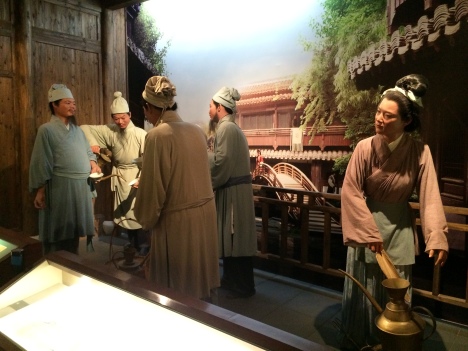
These are the first few things you see walking through the museum. There is a lot of interesting things being presented within the museum. It goes through a lot of the history behind tea, the processes for making tea, traditional wares, traditional settings, and of course tea.
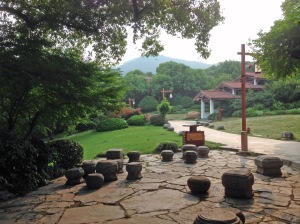 Right outside the Museum there is this amazing statue of Lu Yu and a sitting area with a fantastic view.
Right outside the Museum there is this amazing statue of Lu Yu and a sitting area with a fantastic view.
Plantation:
After walking around the museum you are free to walk around the plantation. Which is huge!
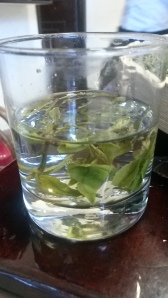
There is a small building on the plantation that allows you to taste and buy some fresh Longjing! The picture on the right shows a few different grades of Longjing that they are offering.
Restaurant:
When your tired of walking around there is this nice restaurant you can stop and eat in!
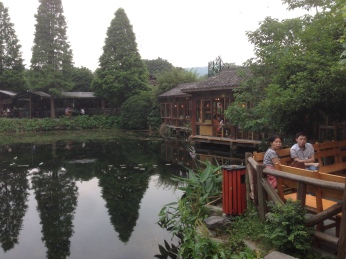
Everything we had was very good, but these two things stood out. Green Tea Beer and Green Cookies. Sorry the cookie picture is a little fuzzy, I was too excited to eat them!
Green Tea: Hangzhou’s Tea Museum
Green Tea: Storage and Shelf Life
Storage and Shelf Life
Typical shelf life for green teas that have not been opened from their packaging can last up to six months. Opened green tea can last about two to three months, from the packaged date. It is important after opening to store the tea in a sealed container. Green tea is very delicate and will easily absorb characteristics from its surrounding. So you want to do everything you can to stop that! After sealing it, place it in a clean area where there is not a lot of “smell”.
Throughout China I saw some store owners storing their green teas and lighter oolongs in refrigerators. Wikipedia refers to this as Aracha, where they are stored in low humidity, almost freezing temperature, and in paper bags. This is supposed to lengthen the “freshness” of the tea. *More research to be done here!*
Brewing Green Tea
Brewing styles change for almost every tea. So I will be including a brewing section in every type of tea. For the beginners I will have an initial post sometime in the future, but it is really important to understand that brewing parameters change with the situation.
Flavor Profiles of Green Tea
*Flavor profiles are difficult for me to explain. I can’t get over the feeling that everyone tastes differently, based on past experiences or lack of exposure to certain tastes.*
Brewing green tea can be somewhat difficult compared to other teas. We have to know what flavors we are aiming to get out of the first brews. Green tea generally gives a nutty smell and taste. Almonds are considered the ideal flavor for green tea by some. This nutty taste has been used as a high quality indicator by most experienced drinkers. In my experience, the taste and smell of green tea changes as it moves from west to east, Yunnan to Japan. As noted in my previous posts, green tea produced in Yunnan tends to be a lot stronger than the ones made in the east. So as a general rule as tea moves towards East China, it tends to become lighter in taste. This can also be related to production areas. As production areas move closer and closer to coastal lines, a more fishy taste comes out of the tea.
Green Tea Brewing
Brewing green tea can be somewhat difficult compared to other teas. If brewed correctly it will produce a very nice and light flavor, but if over brewed just a little, it could turn out sour and unpleasant.
Amount of Tea
3 grams is a standard when starting out with a regular gaiwan. Once you learn a little more you will be able to adjust to your tools. The biggest thing is to watch the amount of leaves and adjust as necessary. Too many leaves could result in an unfavorable taste initially.
Wares
Use lighter wares for green teas. Green tea is a lighter tea and people look for aromas a bit more in green tea. Lighter wares carry the more delicate aromas better. In addition, lighter wares do not hold heat for long, so there will be less of a chance to over brew the tea.
Casual Brewing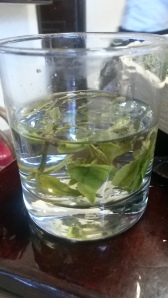
Casual brewing or grandpa style tea is usually made in a mug or tempered glass, something very relaxed. This is also one of the traditional styles of brewing. The brewer is simply trying to enjoy the tea with minimal effort. I see this a lot with Longjing tea. When brewing green tea you can either put the water in first or after you put the tea in the vessel. The fun thing about Longjing green tea is that it will stand up and then lay down when it is fully extracted. You can see this method in the YouTube video below:
Fun video: https://www.youtube.com/watch?v=5kff7OxaWhM
Comparative Brewing
My tea masters says high quality green tea should be able to withstand 100 degree Celsius temperature and still produce a welcoming taste. I completely agree with him when it comes to determining quality. People adjust temperature to produce a better end result and make the tea more appealing. This can cover up all the not so good qualities that may come out in not so good tea. With that said, adjusting the temperature is all part of the skill of brewing. It is what makes Gong Fu Cha.
It is very hard to find green tea that can withstand high temperature water. The biggest challenge when brewing green tea is the temperature of the water used in the first few brews. A lot of sources say that the best temperature to brew green tea is around 65 degrees Celsius. For the second and third brews, you can use slightly warmer water. Green tea usually only lasts four or five brews.
Determining Quality Green Tea Part II
Plantation Vs Wild
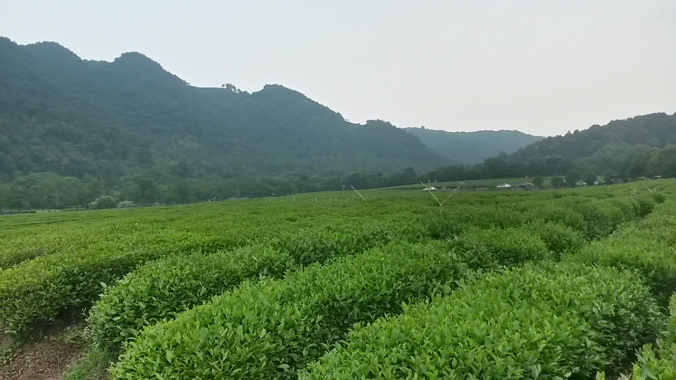
This is an example of a plantation. See how the trees are lines, similar to corn fields. In the back grounds you can see the sprinkler system they use to properly water these plants. Further in the background you see that we are somewhat in the mountains, definitely the lower altitudes.
Some of the most famous teas come from plantations. The thing about plantations is that they are controlled. Most of the time there is a ceiling, meaning that the trees are allowed to grow to a certain height and then are cut down. This makes for easy picking, either by machine or man. Japan is a great example of plantation style growing. A lot of the farms in Japan are plantation with heavy use of machinery. This leads to high productions costs, but that is another topic.
I’m not saying that plantation tea is bad, I’m just want to emphasize that it is a controlled process for growing tea. The green tea on the Hangzhou plantation was probably the best green tea that I tasted in China. I think what plantation producers are really trying to do is create a uniform flavor for their tea.
Wild trees are just that wild tea growing trees. There are a few protected wild trees and growing areas in China. Some actually have armed soldiers protecting the area. These trees range in age, some range from 500 – 800 years. The oldest protected tree is about 2000 years old. The biggest factor with these styles of tea growing areas is the randomization of flavor over the years. I think this is what makes this area so much fun. Being able to taste different areas of China through tea is an interesting practice.
Shaded vs Sun
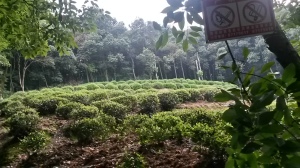
Along with being on the mountain some of the tea plants are naturally shaded by surrounding trees. Someone literally cut out a square and planted these trees. The surrounding trees offer more shade, compared to the more open plantations.
Tea producing trees that are somewhat shaded are producing some high quality teas. The shade increases the quality of the leaves. The chemistry behind it is this: “shade increases chlorophyll production in the plants by reducing natural photosynthesis in the leaves.” This increases the quality and flavor of the trees in that area. You will see a lot of mountain teas out there. A simple reasoning behind this is that direct sun is only on tea plants for so long, as the sun will be on the other side of the mountain for half the day. On some plantations you may see other older trees that are providing shade to the smaller tea plants. On more industrial plantation you may actually see sort of roof covering the tea leaves.
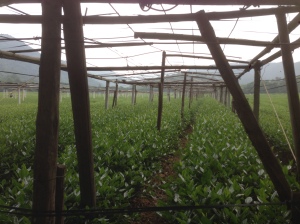
I’m not completely sure what these were used for. I can imagine that they would be able to through a tarp or form of covering over these plants. Maybe when it is too sunny out.
Tea produced in direct sun may not always be of the best quality. The leaves have a higher risk of burning. In regards to green tea, most of the good stuff is single origin and not blended. So you are going to taste the burnt leaves easier. Blending or mixing in puer is more common, so you may actually see some more direct sun growing areas. Sencha is actually known for being grown in full sunlight.
The sun exposure actually increase the catechins (EGCG) in the leaves producing green tea. For more chemistry and knowledge on this subject, I will have to catch up with my food science and chemistry friends.
This brings this section to a close! Check out the next section, Brewing Green Tea + Storage!
Determining Quality Green Tea Part I
This post I will try to show you where quality tea is coming from, what forms they take, the differences in growing styles, and possibly some well-known teas.
Let’s get back in to shapes and explain where it is most common to find each shape. There are a few main shapes, rolled or curled, strand, and crushed. I learned a fun way to remember a general tip for locating where a certain tea is from, strand in the north, balled in the south. I’ll let you make the connection.
**This is general and a result of my experience with green tea. Feel free to test this on your own**
In China there are quite a few places green tea is produced. A very famous location is in Hangzhou. There is a tea museum there that is actually on a tea plantation. The tea that is most well-known is called Longjing, there is West Lake Longjing and Zhejiang. Longjing is also known as Dragonwell, I have seen these terms used interchangeably. This type of tea usually comes in a softer strand form.
.
China also has rolled forms that is coming more from the Southern areas of Fujian and Yunnan. Bi Luo Chun is a well-known tea that is often rolled. In regards to the green teas coming out of Yunnan, they are usually stronger and bolder in taste. Yunnan is a puer producing area so the green teas are actually coming from these powerful puer trees. We will further discuss taste in the flavor profiles and brewing section.
Taiwan is producing green teas as well. In my time there I saw a lot more balled green teas than strand. It is actually pretty hard to initially tell the difference between the balled green teas and the balled oolong. If you look closely at the leaves, the green tea seems to be a little looser than the balled oolong. This deserves some further research!
Korea has some impressive green teas! The guys at the Penn State Tea Institute had the opportunity to visit a Korean Tea Master, his plantation, and actually got the chance to make some of their own green tea. The one tea I had the opportunity of tasting was called Sejak and was in strand form.
A lot of Japan’s tea culture is focused around green tea. Matcha and Sencha are the first teas that come to mind. Matcha is the form of tea that is usually grounded and machine crushed. Everyone has probably seen this whisked in a bowl. Sencha can also be crushed but can take on the leaf form. In my experience sencha has small stranded style. One source even went as far to say that the only difference between these two is the way in which the tea plant are grown. One is mostly shaded and the other has more direct sun. This segways us into the shaded vs sun area, but we must know some a little about plantation and wild tea origins.
–>>>> PART II
